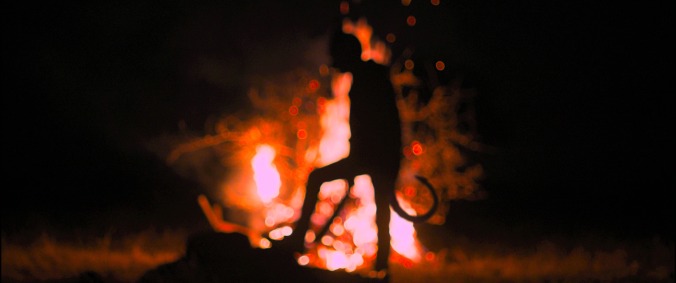Identifying Features is among the greatest, most devastating films about Mexico’s drug war

Some movies wound us so profoundly that once darkness has consumed their final frame we are incapable of shaking off the heartache. That’s the power of Identifying Features, which is as painfully intimate as it is unsparing in its indictment of a country ravaged by a corrosive, entrenched evil. Making her feature debut, Mexican writer-director Fernanda Valadez finds a personal tragedy within a national one—the murder or disappearance of thousands of people, the mass collateral damage of the ongoing drug war. She’s made a humanitarian lament by way of a slow-burn thriller.
Magdalena (Mercedes Hernández), from Guanajuato, travels north to the border in search of her underage son, Jesús (Juan Jesús Varela). Two months earlier, he agreed to migrate to the U.S. with his best friend, Rigo (Armando García), in hopes of overcoming their adverse economic circumstances. In that time, no news of the boys’ whereabouts has arrived. In a sobering opening scene that sets the tone of what’s to come, Rigo’s mother recognizes her child, who sports a pronounced facial birthmark, in a photo of the dead. But there are still no answers for Magdalena. If they were together, where is Jesús? Lacking unique identifying features, in the eyes of the authorities, he’s just another nameless dream-seeker the earth swallowed.
Industrious despite her small frame and meek presence, Magdalena walks on, every step leading her closer to closure—or so she expects. She is a private investigator in an arid landscape of mass graves, burnt bodies, and missing buses, where a recovered bag becomes her child’s only tangible remains. Identifying Features doesn’t intellectualize the cross she bears. The script, cowritten by Astrid Rondero, never forces her to vocalize her excruciating worry, the guilt she may harbor for agreeing to let him leave (even as she consoles the parents of the other boy, relinquishing them of their culpability), or the rage at the magnitude of the devastation that’s become the Mexican normality. “My son might be dead, but I have to know,” is about all she says. Perhaps only a mother could ever conjure such tireless strength amid crippling despair; she wants only peace of mind. Hernández, in her first lead role, conveys largely through gestures the soul of a woman on the verge of collapse, preserving her energy for the inhospitable excursion.
Fear is a great equalizer in this setting, infecting every aspect of civil life. Along the way, Magdalena crosses paths with others on their own pursuits, each pointed encounter touching upon multiple factors of migration or how the pervasive violence also affects people in higher socioeconomic strata than hers, such as a surgeon searching for her own son. Of those she meets, the most significant might be Miguel (David Illescas), a young man trekking back to his rural home after being deported from the States; we first see him in an alluring tracking shot, crossing the bridge that divides the two countries, a tiny speck framed by a sea of endless break lights. From behind, he could be anyone. The road will eventually bring Miguel and Magdalena together, providing her with the glimmer of a possible future and perhaps the prospect of a surrogate family—feelings inspired, no doubt, by the parallels between him and her lost son, whose different situations represent the consequences of the conditions that drive people to desperately leave or reluctantly return.
Claudia Becerril Bulos, the intrepid director of photography, supplies a fittingly oppressive melancholia, in a film that makes pointed choices about what to hide and what to highlight. Her camera often seems as terrified as the characters, hiding as it does behind windows and other partitions, and she surveys many scenes from a distance, visually representing the tense secrecy that surrounds the atrocities everyone knows about but few dare to speak of. Throughout, Magdalena’s face is often lit with the incandescent red of a fire, as if she’s staring directly into the man-made hell her homeland has become. The film’s command of symbolism is most stunning during an encounter with a survivor, recounting the traumatic events he witnessed in an indigenous language that Valadez translates purely through imagery.
Implying more than it shows, Identifying Features is visceral without ever succumbing to the exploitative shock value of cartel stories of the big and small screen alike. It’s one of the best films to ever address this crisis, on par with documentary counterparts like Everardo Gonzalez’s Devil’s Freedom or Tatiana Huezo’s Tempestad. Valadez bypasses politics to get closer to an emotional truth about Mexico’s drug war, contemplating its horror as an all-affecting affair rather than pointing fingers. Eventually, the filmmaker heads in a more allegorical direction, with a nightmarish sequence of color and light. What could have been a facile equivalence, drawing a connection between the sadistic perpetrators and the devil himself (a figure important to a country as vastly Catholic as Mexico), is elevated by the overwhelming sensory experience of these climactic moments, all ghostly visions and otherworldly music. This is the rare movie with the power to leave one physically rattled.
Gasping for a breath of hope that never comes, an almost indescribable grief sharply sets in. This movie hurts, and it should hurt because of the bloodstained reality of the conclusion, which surpasses in sheer abhorrence any fictional abyss. Magdalena has seen the burning blaze of wickedness, and she’s been given a choice between the earthly death of the one she loved most and the ravaging of her spirit. If only her tears could extinguish the flames. There among the moral rubble, putting together the implications of Magdalena’s final decision, Identifying Features leaves its last bruise, making searing poetry out of suffering so brutal to the soul that it can scarcely be put into words.